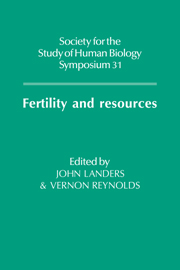Book contents
- Frontmatter
- Contents
- List of contributors
- 1 Introduction
- 2 Environmental and social determinants of fecundity in primates
- 3 Biological aspects of fertility among Third World populations
- 4 A preliminary report on fertility and socio-economic changes in two Papua New Guinea communities
- 5 The cultural context of fertility transition in immigrant Mennonites
- 6 Inter-relationships between consanguinity, religion and fertility in Karnataka, South India
- 7 Resources and the fertility transition in the countryside of England and Wales
- 8 Fertility decline and birth spacing among London Quakers
- 9 Population growth, innovation and resource exploitation
- 10 Fertility decline in developing countries: the roles of economic modernization, culture and Government interventions
- 11 Understanding recent fertility trends in the Third World
- 12 Monogamy, landed property and demographic regimes in pre-industrial Europe: regional contrasts and temporal stabilities
- Index
7 - Resources and the fertility transition in the countryside of England and Wales
Published online by Cambridge University Press: 13 March 2010
- Frontmatter
- Contents
- List of contributors
- 1 Introduction
- 2 Environmental and social determinants of fecundity in primates
- 3 Biological aspects of fertility among Third World populations
- 4 A preliminary report on fertility and socio-economic changes in two Papua New Guinea communities
- 5 The cultural context of fertility transition in immigrant Mennonites
- 6 Inter-relationships between consanguinity, religion and fertility in Karnataka, South India
- 7 Resources and the fertility transition in the countryside of England and Wales
- 8 Fertility decline and birth spacing among London Quakers
- 9 Population growth, innovation and resource exploitation
- 10 Fertility decline in developing countries: the roles of economic modernization, culture and Government interventions
- 11 Understanding recent fertility trends in the Third World
- 12 Monogamy, landed property and demographic regimes in pre-industrial Europe: regional contrasts and temporal stabilities
- Index
Summary
Introduction
Between 1871 and 1931, the average completed family size in England and Wales declined from around six or seven children to around two or three children. This decline in fertility was unprecedented; it was universal in that it ultimately affected all sections of society; and, so far as we can tell at present, it was irreversible. It was a social change of monumental importance and has been aptly labelled the fertility transition. Together with the decline in mortality which took place after 1750, it forms the well known phenomenon of the demographic transition.
The fertility transition in England and Wales had two important characteristics. First, it was due almost entirely to a decline in fertility within marriage: the propensity of the population to marry hardly changed (Figure 7.1). Second, it involved a shift from uncontrolled to controlled fertility as married couples began to take conscious decisions to limit the number of children they had. It is argued (for example by Knodel, 1988: pp. 247–349) that this shift involved the gradual adoption by the population of ‘stopping’ behaviour, whereby couples began to use fertility control methods once they had produced their desired number of children.
Notwithstanding these dramatic temporal changes, it has until recently been conventional to assert that geographical variations in fertility levels and trends during this period were small (Brass & Kabir, 1977: p. 87; Teitelbaum, 1984: pp. 88–9 and 149). A lack of regional variation was thought to have characterized not only overall fertility, but also its two major components: nuptiality and fertility within marriage (or marital fertility).
- Type
- Chapter
- Information
- Fertility and Resources , pp. 76 - 91Publisher: Cambridge University PressPrint publication year: 1990
- 1
- Cited by



